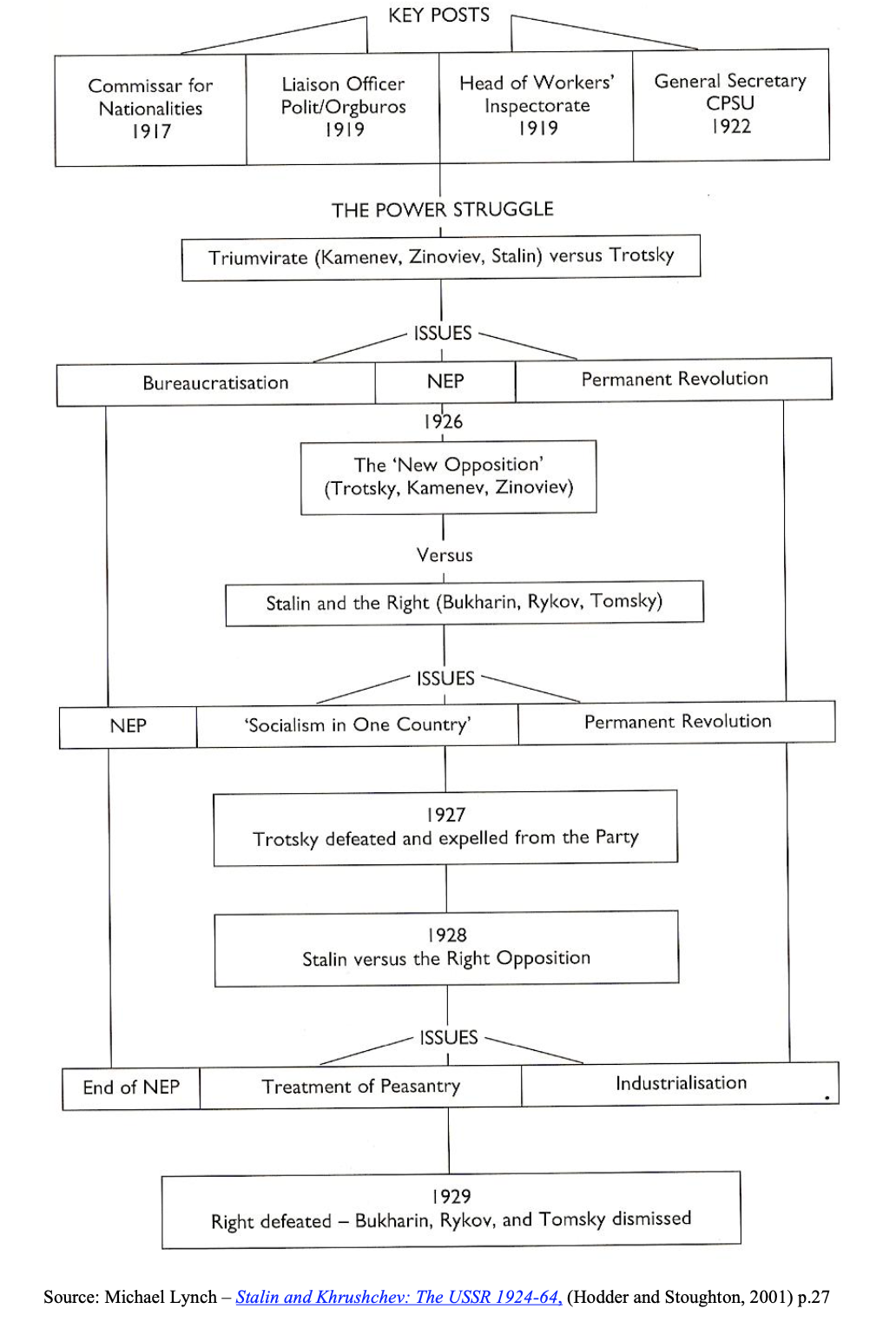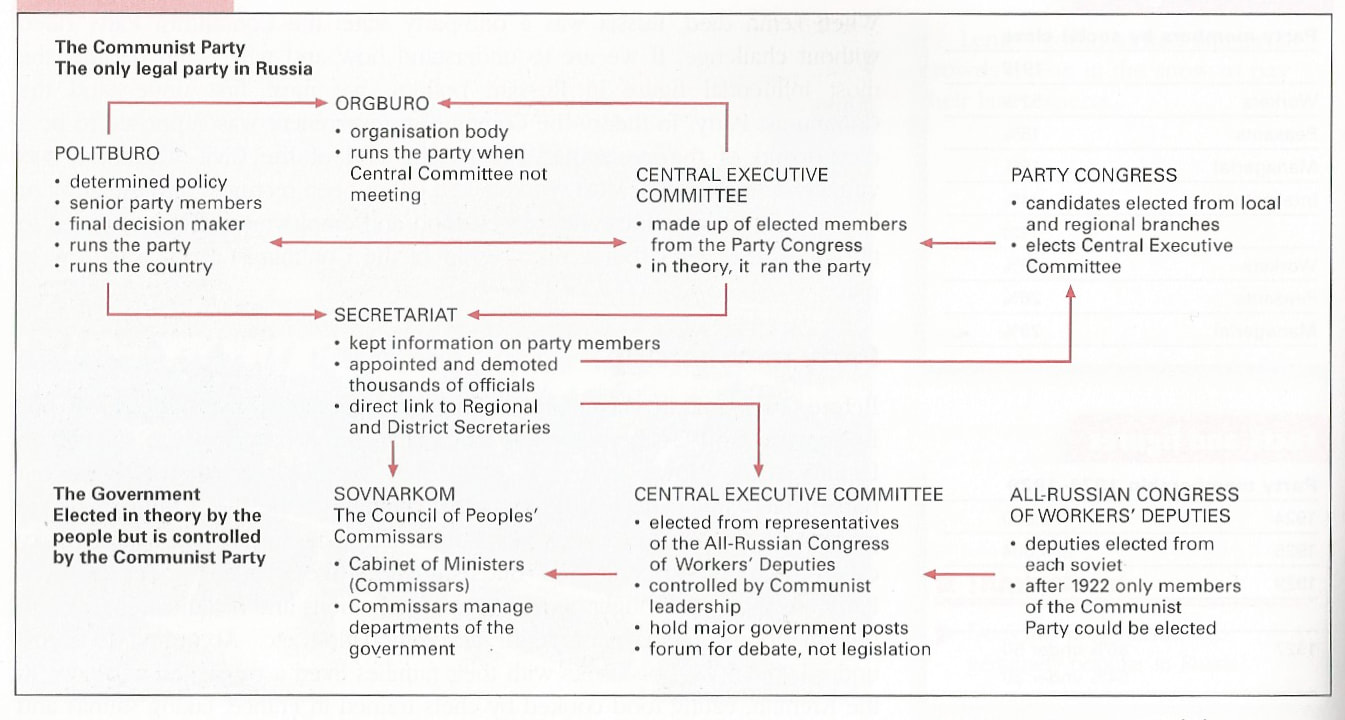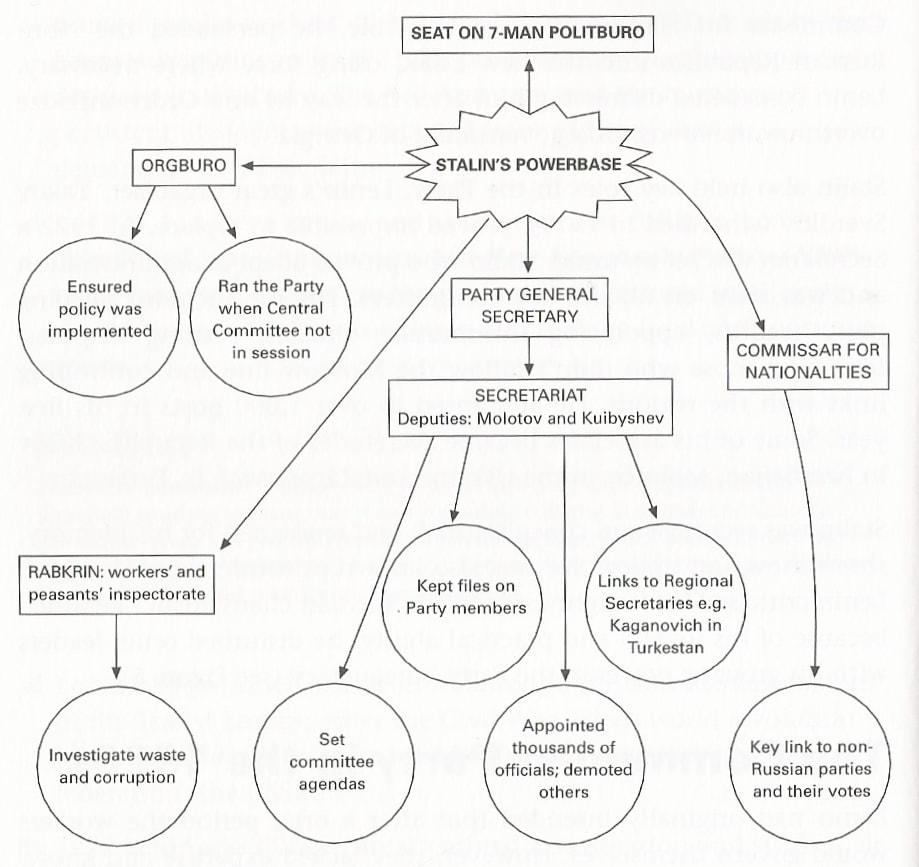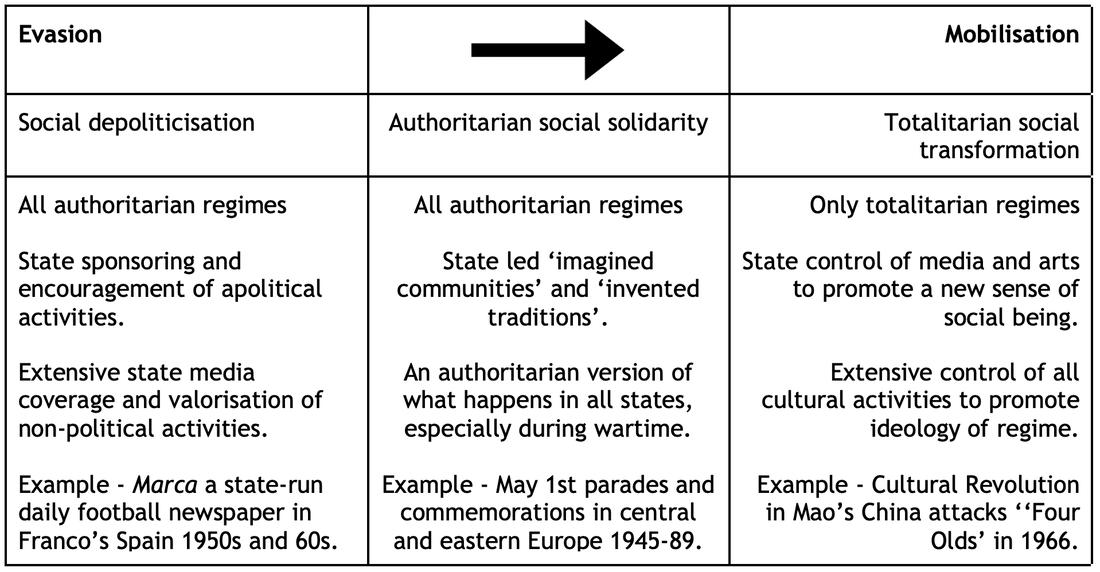Lesson 6 - Research and presentation assignment - Stalin
Stalin provides us with a significantly different case study in totalitarianism when compared to the fascist examples of Mussolini and Hitler. Most importantly, the ideological differences of Communism had a significant impact on the aim and policies of the regime and the extent to which the state was able to control the lives of the individual.
|
In brief, the Communist state abolished capitalism and replaced the free market with a command economy in which the state took on the responsibility for the production and distribution of resources. This not only increased the power of the state, it also created a massive bureaucracy in which Communist Party members exercised considerable power. This new class of 'nomenklatura' provided the regime with the basis of its popular consent, controlling the new hierarchical 'prerogative state' in which the chairmanship of the party became the most important position of power in the country.
Stalin became chairman of the Communist Party in 1922, before state control over the economy was fully established and before the significance of the position was fully appreciated. |
|
1. The rise to power
This presentation must build on your knowledge and understanding of the earlier topic of the Russian Revolutions (Matu 8). One of the most important debates between historians was about the extent to which Stalin was simply the logical continuation of what Lenin had established. This complicates the analysis slightly because the rise to power of Stalin needs to be understood in the wider historical context of the events of 1917-24. In this case study the key structural factors are largely to be found in the long-term causes of Stalin's rise to power during the revolution and Civil War, which provided a violent and chaotic context in which a man like Stalin might do well. As Orlando Figes has said the rise to power of Stalin was effectively, the 'Rise of a Gangster'. When focusing on the role of human agency we move to events of 1924-29 in which Stalin gradually seizes power.
|
Structural Factors
It is certainly worth considering the whole PESC (+W) list of structural factors that enabled the 'rise of the gangster'. Politically consider the actions of Lenin to destroy nascent democracy in 1918 and the lack of any democratic traditions in Tsarist Russia. Remember democracy means more than voting. The crushing of the Kronstadt Uprising which ended the Bolsheviks pretence to be governing with the support of popular Soviets could all be justified in terms of Marx's concept of the Dictatorship of the Proletariat. |
|
|
The crisis of the Civil War and the period of War Communism created an economic context (with obvious social and political consequences) that strengthened the grip of the Communist Party over the Russian state. Spend time reviewing the context on our two previous lessons on this content: how did the Bolsheviks consolidate their power and the Civil War. John D Clare provides a clear overview with useful links and Spartacus explains the significance of War Communism.
|
|
Human Agency
'Stalin, gave me the impression…of a grey blur which flickered obscurely and left no trace. There is really nothing more to be said about him.' (Menshevik politician Nikolai Sukhanov in his memoirs of the Russian Revolution of 1917).
Textbook pages 126-7 provide you with the basic information of how Stalin brilliantly exploited both his rising position within the Communist Party and the tendency of his rivals to underestimate him as a mere 'grey blur'. As Trotsky himself said 'To the leading group of the party (in the wider circles he was not known at all) he always seemed a man destined to play second and third fiddle'. Lenin, of course, realised too late the dangers that Stalin posed. For Stalin the most important act was to diffuse the ticking time bomb which was Lenin's Testament. The first film below provides you with eyewitness testimony of how he was able to do this.
Textbook pages 126-7 provide you with the basic information of how Stalin brilliantly exploited both his rising position within the Communist Party and the tendency of his rivals to underestimate him as a mere 'grey blur'. As Trotsky himself said 'To the leading group of the party (in the wider circles he was not known at all) he always seemed a man destined to play second and third fiddle'. Lenin, of course, realised too late the dangers that Stalin posed. For Stalin the most important act was to diffuse the ticking time bomb which was Lenin's Testament. The first film below provides you with eyewitness testimony of how he was able to do this.
|
The diagram to the right explains the gradual, political manouevering behind Stalin's rise to power. It begins by identifying the key posts that enabled Stalin to control the Party apparatus and increase his power of patronage. It then outlines the three major power struggles which Stalin won to give him absolute power by 1929.
|
Other sources worth considering:
Stephen Lee essay on why Stalin succeeds Lenin.
Jim Grant explains the historiography of Stalin's Rise to Power.
John D Clare on Stalin's rise to power with links.
Stephen Lee essay on why Stalin succeeds Lenin.
Jim Grant explains the historiography of Stalin's Rise to Power.
John D Clare on Stalin's rise to power with links.
|
2. Consolidation and maintenance of power
Stalin inherited much of the machinery of totalitarian control from Lenin. The single party control over a new prerogative state was in place from 1919 and informal social control was exercised through censorship and propaganda. But Stalin went further. It can be argued that there were two key stages in Stalin's consolidation of power. The first began in 1928 with the launch of the First Five-Year Plan and his attack on the Right Opposition. The second stage came after the murder of Kirov in 1934 which led to the purges and show trials of the former Bolshevik leaders including Kamenev, Zinoviev and Bukharin. |
|
Coercion – Formal social control.
|
Replacing of the old ‘normative’ state with the new authoritarian ‘prerogative’ state had largely been completed under Lenin. Legal coercion was important. As you can see in the diagram below (source - Oxley, Russia, 2001) there were plenty of elections and the Sovnarkom was a government elected by the people. But in reality power lay in the Communist Party and its most important committee the Politburo. The party was run as it always had been secretively and hierarchically. It had begun as an organisation trying to evade the Tsarist state and then it had developed into a military machine set up to win a civil war. The most important positions in the Party were not decided democratically, but rather through hierarchical appointment.
|
Stalin's powerbase (source - Grant, Stalin, 1998) was founded on his ability to control the appointment of those looking to make their career in the Party. Those he appointed owed their position to him; those who wanted promotion, needed to prove their loyalty and usefulness to him. After Stalin the most important person in the USSR was always the General Secretary.
|
As with many dictators it is often hard with Stalin to distinguish the aims of policy with the pursuit of power. The attempt to modernise Russia through the Five-Year Plans and collectivisation were extraordinarily ambitious economic policies which had enormous social consequences. But they also had a political intent. Ending the NEP provided Stalin with an opportunity to consolidate his position. As the historian James William Crowl has argued: 'Stalin With the defeat of Trotsky and the Left Wing in 1927, Stalin apparently began to look for a way to outmaneuver the final power bloc in the Party: the Right Wing led by Bukharin, Rykov and Tomsky. It was not by accident that the economy provided him with the issues he needed to destroy his erstwhile allies.' (Spartacus) The textbook pp.128-133 covers the Five Year Plans, but remember the economic and social dimension will be the responsibility of the next group's presentation. The Purges are covered by p.134 and by John D Clare and Spartacus.
|
|
|
Other aspects to consider in your research include the importance of the secret police (NKVD), the concentration/labour camps (Gulag) and the role of denuciation. After 1932 an internal passport was introduced that helped the state control the movement of citizens. The Tsarist labour camps in Siberia were closed in 1917 only to be reopened by Joseph Stalin as Glavnoye Upravleniye Lagere (Gulag). It has been estimated that 18 million entered the Gulag and roughly 1.5 to 1.7 million perished and another 6 million were sent into exile in Siberia. (Anne Applebaum, in Gulag: A History) If the size of the secret police is an indication about the degree of totalitarianism, then Stalin's NKVD certainly exercised greater control than Hitler's Gestapo. At the end of the 1930s there was 1 Gestapo worker and 1 informer per 2,500 of population. At the same period, the NKVD, 1 NKVD man per 500 of population - five times the saturation level of Nazi Germany. (Sheila Fitzpatrick)
Persuasion - Informal social control.
|
As with all presentations, you need to begin your research by reminding yourself of how informal social control was developed in Lenin's Russia. Under Stalin state social control exemplified what we have previously characterised as totalitarian social transformation.
Propaganda and censorship were centrally organised and the distinction between the arts and propaganda, education and indoctrination begin to break down. Mobilisation of the public in support of the regime is crucial. The Five-Year Plan requires enormous effort and sacrifice and eveyone is expected to play their part in building socialism. The myth of Pavlik Morozov and the heroic worship of Alexei Stakhanov are interesting examples worth researching in this respect. Radio Free Europe on Stalin Australian National University on Cult of Stalin in Posters |
|
3. Aims and results of policies
'We need not invoke either too lofty of too base a view of human nature to explain the durability and stability of the state formations of Communist regimes. We need only accept the commonplace, that in most times men are guided by a prudent concern for their own welfare and for that of those who are close to them. It is, therefore, unremarkable that where all the prospects for advancing that welfare are in the hands of the state, and where it is clear that the condition for advancement is support for its policies, then few will rebel.' (Neil Harding - The State in Socialist Society 229) |
|
Consent
As we have previously seen the following means of generating consent in authoritarian regimes is important and certainly applicable in Stalin's Russia. Explicit consent was generated by:
In 1924 there had been 472,000 Party members, by 1928 there were already 1.3 million. The new party members were young, uneducated workers and peasants, the ideological backbone of the Marxist state and ready to appreciate the material advantages of social mobility. With the expansion of the state as a consequence of the Five-Year Plan membership stood at 3.5 million by 1934. The vast majority of these co-opted members had enjoyed significant social mobility and were ready to believe in the goal of socialism made realistic with the economic achievements of the Five-Year Plan. For the vast majority of the rest of population it was all about coming to terms with the new reality of a world in which the allocation of scarce resources depended on your ability to say and do the right thing at the right time. This is what we mean by passive consent. Read the quotation at the top of this section by my old teacher Neil Harding: 'In most times men are guided by a prudent concern for their own welfare and for that of those who are close to them'. So when the state is the guarantor of access to welfare provision, it is understandable that most people are unlikely to rebel.
Economic, social, cultural and foreign policy.
As we have previously seen the following means of generating consent in authoritarian regimes is important and certainly applicable in Stalin's Russia. Explicit consent was generated by:
- Political engagement - Just as in democratic regimes authoritarian states often use elections that allow citizens to choose between representatives with different political programmes.
- Co-optation - Long lasting authoritarian regimes also successfully generate explicit consent from those individuals who are co-opted into the state power apparatus. By providing a significant number of citizens with positions of responsibility, the state creates a political and administrative class who have a vested interest in the survival of the regime.
- Social mobility - A related means of generating explicit consent in an authoritarian regime, as in all regimes, is through encouraging social mobility. The successful authoritarian state must provide a degree of social mobility in which the powerless can move up into positions of responsibility, in return for their loyalty and support of the regime.
- Ideological commitment. Finally, we must consider the importance of ideological incentive. These are not people who are passive victims of propaganda and indoctrination, but genuine believers.
In 1924 there had been 472,000 Party members, by 1928 there were already 1.3 million. The new party members were young, uneducated workers and peasants, the ideological backbone of the Marxist state and ready to appreciate the material advantages of social mobility. With the expansion of the state as a consequence of the Five-Year Plan membership stood at 3.5 million by 1934. The vast majority of these co-opted members had enjoyed significant social mobility and were ready to believe in the goal of socialism made realistic with the economic achievements of the Five-Year Plan. For the vast majority of the rest of population it was all about coming to terms with the new reality of a world in which the allocation of scarce resources depended on your ability to say and do the right thing at the right time. This is what we mean by passive consent. Read the quotation at the top of this section by my old teacher Neil Harding: 'In most times men are guided by a prudent concern for their own welfare and for that of those who are close to them'. So when the state is the guarantor of access to welfare provision, it is understandable that most people are unlikely to rebel.
Economic, social, cultural and foreign policy.
|
Your textbook is fine on the economic aspects of the Five-Year Plans and collectivisation. It also covers some of the social consequences. Apart from the 'cult of Stalin', it has nothing much to say about the cultural policies. You can, however, get an excellent overview with great examples from this textbook - Peter Oxley, Russia 1855-1991, From Tsars to Commissars.
On the disastrous impact of collectivisation on the farming community in the Ukraine and the successful attempt to keep it quiet, see the film about the Welsh journalist Mr Jones. |
|
Summary sheet taken from James Mason Modern World history to GCSE.
Jim Grant on who won and lost in Stalin's Russia.
JDC on the social consequences of Stalin's policies and on Collectivisation and Five Year Plan
Jim Grant on who won and lost in Stalin's Russia.
JDC on the social consequences of Stalin's policies and on Collectivisation and Five Year Plan
|
|
One of the best illustrations of the complex, sometimes contradictory nature of Stalin's policies is the story of the town on Magnitogorsk as told by the American communist who worked there, John Scott. The film 'Life in Stalin's Russia' a BBC schools production is based on Scott's book Behind the Urals. This worksheet produced for my European School students a few years ago contains some interesting extracts from the book.
See also striking images and video from 17 moments in Soviet History website - Magnetic mountain. |
Full Documentaries
|
|
|
|
|
|
|
|
|
|
|





